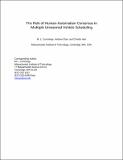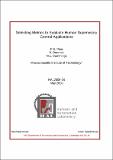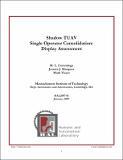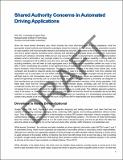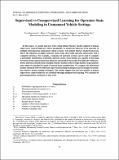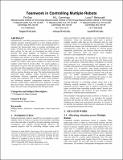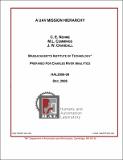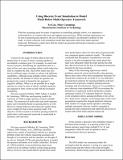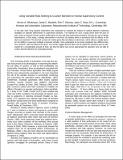Browsing HAL Reports by Title
Now showing items 59-69 of 69
-
The Role of Human-Automation Consensus in Multiple Unmanned Vehicle Scheduling
(The Role of Human-Automation Consensus in Multiple Unmanned Vehicle Scheduling, 2010)Objective: This study examined the impact of increasing automation replanning rates on operator performance and workload when supervising a decentralized network of heterogeneous unmanned vehicles. Background: Futuristic ... -
Selecting Metrics to Evaluate Human Supervisory Control Applications
(MIT Humans and Automation Laboratory, 2008)The goal of this research is to develop a methodology to select supervisory control metrics. This methodology is based on cost-benefit analyses and generic metric classes. In the context of this research, a metric class ... -
Shadow TUAV Single Operator Consolidation : Display Assessment
(MIT Humans and Automation Laboratory, 2007)Currently, Shadow UAV operations require two people: the Air Vehicle Operator (AVO) and the Mission Payload Operator (MPO). A previous workload study demonstrated that it is possible to combine these two positions such ... -
Shared Authority Concerns in Automated Driving Applications
(2014-05-13)Given the move toward driverless cars, which includes the more short-term goal of driving assistance, what the appropriate shared authority and interaction paradigms should be between human drivers and the automation remains ... -
Supervised vs. Unsupervised Learning for Operator State Modeling in Unmanned Vehicle Settings
(Journal of Aerospace Computing, Information, and Communication, 2011)In this paper, we model operator states using hidden Markov models applied to human supervisory control behaviors. More specifically, we model the behavior of an operator of multiple heterogeneous unmanned vehicle systems. ... -
Supporting Intelligent and Trustworthy Maritime Path Planning Decisions
(International Journal of Human Computer Studies, 2010)The risk of maritime collisions and groundings has dramatically increased in the past five years despite technological advancements such as GPS-based navigation tools and electronic charts which may add to, instead of ... -
Teamwork in controlling multiple robots
(ACM/IEEE, 2012)Simultaneously controlling increasing numbers of robots requires multiple operators working together as a team. Helping operators allocate attention among different robots and determining how to construct the human-robot ... -
A UAV Mission Hierarchy
(MIT Humans and Automation Laboratory, 2006)In the following sections, each of the primary missions are decomposed into mission planning, management, and replanning segments in order to identify what the primary functions a human operator will need to perform. The ... -
Unloved Aerial Vehicles: Gutting its UAV plan, the Air Force sets a course for irrelevance
(Armed Forces Journal, 2012-11)This month's cover article challenges Air Force leader on the subject of unmanned aerial vehicles. Lt. Col. Lawrence Spinetta and Missy Cummings see disaster, or at least a long-term slide into irrelevance, in recent ... -
Using Discrete Event Simulation to Model Multi-Robot Multi-Operator Teamwork
(Human Factors and Ergonomics Society, 2012-10)With the increasing need for teams of operators in controlling multiple robots, it is important to understand how to construct the team and support team processes. While running experiments can be time consuming and ... -
Using Variable-Rate Alerting to Counter Boredom in Human Supervisory Control
(HFES, 2012-10)A low task load, long duration experiment was conducted to evaluate the impact of cyclical attention switching strategies on operator performance in supervisory domains. The impetus for such a study stems from the lack ...

